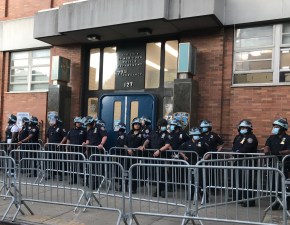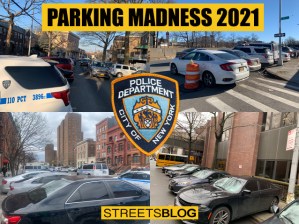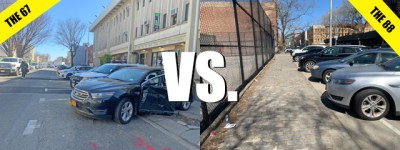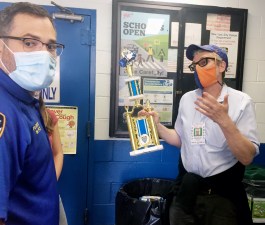Cops Cuff Black Man for Riding on the Sidewalk — And Stats Show Just How Commonly They Do That

A Black man was handcuffed and arrested on Thursday night after cops stopped him for biking on the sidewalk in Downtown Brooklyn — and a witness called the incident unnecessary and traumatic given the recent police killing of Tyre Nichols in Memphis.
According to the witness, cops from the 88th Precinct — the same station house where cops park on the sidewalk and regularly seize a playground to park their personal vehicles — ripped away the bike of the 31-year-old cyclist, put him in handcuffs and brought him to the Classon Avenue station house after he refused to hand over his identification and name so they could write him a ticket for the low-level offense.
“Clearly he was really upset, probably triggered, and having a hard time processing what was happening. And so I calmly pleaded with (the cops) to just drop it. I said, ‘This is a really sensitive time especially with Tyre Nichols. Please just let him go,'” said the witness, who asked to remain anonymous because she has dealings with the legal system as an attorney.
The witness told Streetsblog that other bystanders said the officers just “jumped this kid” because he was riding on the sidewalk. She added that cops told her they’ve gotten complaints from nearby Long Island University about people riding bikes on the sidewalk.
Reporter @Julcuba is reviewing the 2022 "bicycling on sidewalk" tickets written by the NYPD. There were 413 such tickets with race identified; 346 tickets (or 84%) went to Blacks or Hispanics, who are just 50% of the population. Story to follow: https://t.co/HIRpGuaN5T
— Streetsblog New York (@StreetsblogNYC) February 3, 2023
“They were saying, ‘We’ve had a lot of problems with people riding bikes on the sidewalks around here, LIU had been putting in complaints about it,’” she said.
And when the witness said she first showed up, there were just two or three cops at the scene, but by the time they drove off, there were nearly 20, she said — a misuse of resources given the clear and present dangers of biking on Flatbush Avenue, according to safe-street advocates.
“We must end the criminalization of Black and Latino New Yorkers getting around the city,” said Elizabeth Adams, Senior Director of Advocacy and Organizing at Transportation Alternatives. “Instead of wasting resources on targeting people of color, the city should invest in building safe places for people to bike, and prioritize neighborhoods that have long been underinvested in.”
Police confirmed they issued the 31-year-old a summons for “riding a bicycle on a public sidewalk” near Fleet Place and Willoughby Street at about 6:45 p.m. The cops did not respond to further requests for comment about the arrest or summons. And Long Island University did not respond to a request for comment.
The NYPD has a history of harassing people of color and ticketing them for non-violent offenses like riding on the sidewalk, according to city data, which is mapped below.
According to the most recent stats, police wrote 421 summonses for biking on the sidewalk last year. Removing tickets which did not list the suspect’s race, a whopping 200 tickets, or 48 percent went to Black people, and 146, or 35 percent, went to Hispanic people. Only 35 tickets, or 8 percent, were written to white people, who comprise roughly 40 percent of the city population. Black and Latino people comprise roughly 50 percent.
And more specifically, 193 tickets went to Black men, while seven went to Black women, and just five went to white women. White men similarly received just 30 tickets — also wildly disproportionate figures.
And a large portion of the tickets written by cops are in predominantly Black and brown neighborhoods like Jamaica, Bedford-Stuyvesant, Brownsville, and the South Bronx, according to the data.
Cops have discretion when it comes to writing summonses or making arrests, according to Molly Griffard, a staff attorney at the Legal Aid Society — but cops disproportionately summons Black and brown residents for public urination, sleeping on a park bench, and riding on the sidewalk.
Instead, Griffard said, the city should put its resources into building out safer bike infrastructure, rather than arresting young Black men for just trying to get home safely.
“You have here a perfect example of the lack of safe biking infrastructure, is often what forces cyclists onto the sidewalk and we can’t police our way out of that. and unfortunately it’s where we see a lot of the focus on a lot of these broken windows offenses rather than really going after the root causes leading to the behavior,” said Griffard.





